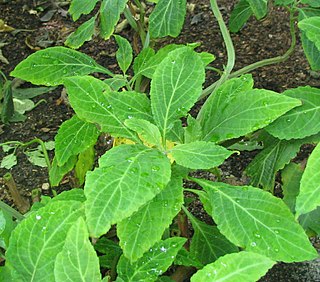This article includes a list of general references, but it lacks sufficient corresponding inline citations .(May 2010) |
Various plants are used around the world for smoking due to various chemical compounds they contain and the effects of these chemicals on the human body. This list contains plants that are smoked, rather than those that are used in the process of smoking or in the preparation of the substance.
- Actinidia arguta
- Areca catechu
- Althaea officinalis ~ Marshmallow
- Amaranthus dubius
- Anabasis aphylla
- Anaphalis margaritacea ~ Pearly everlasting [1]
- Arctostaphylos uva-ursi ~ Bearberry
- Argemone mexicana
- Arnica species ~ Mountain tobacco
- Artemisia douglasiana
- Artemisia vulgaris ~ Mugwort
- Asparagus officinalis
- Aquilaria sinensis
- Brassica oleracea ~ Cabbage
- Calea zacatechichi
- Calendula officinalis
- Camellia japonica
- Camellia sasanqua
- Canavalia maritima ~ Baybean
- Cannabis ~ both THC and CBD
- Cecropia mexicana ~ Guamura
- Cestrum nocturnum ~ Hasana ???
- Ceratonia siliqua
- Cynoglossum virginianum ~ Wild comfrey [2]
- Cytisus scoparius
- Entada rheedii
- Eschscholzia californica ~ California poppy
- Fittonia albivenis
- Heimia montana
- Heimia myrtifolia
- Heimia salicifolia
- Heracleum giganteum
- Hippobroma longiflora
- Humulus japonica ~ Japanese hops
- Humulus lupulus ~ Hops
- Hypericum erectum
- Ilex guayusa
- Lavandula species ~ Lavender
- Lactuca virosa ~ Lettuce opium
- Laggera alata ~ ?
- Lamiaceae species ~ Mint
- Leonotis leonurus ~ Lion's tail or wild dagga
- Leonurus cardiaca ~ Motherwort
- Leonurus sibiricus ~ Honeyweed
- Lobelia cardinalis
- Lobelia inflata ~ Indian-tobacco [3]
- Lobelia siphilitica
- Lilium lancifolium
- Lilium longiflorum
- Matricaria chamomilla
- Morus alba
- mitragyna speciosa
- mitragyna parvifolia
- Myristica fragrans
- Musa acuminata ~ bark
- Musa balbisiana ~ bark
- Musa basjoo ~ bark
- Nepeta cataria ~ Catnip
- Nauclea latifolia ~ Tramadol
- Nicotiana species ~ Tobacco
- Nymphaea alba ~ White lily
- Nymphaea caerulea ~ Blue lily
- Nymphaea nouchali
- Opuntia ficus indica
- Origanum majorana ~ Marjoram
- Origanum vulgare ~ Oregano
- Papaver Bracteatum
- Papaver Paeoniflorum
- Papaver Setigerum
- Papaver somniferum ~ Opium poppy
- Passiflora incarnata ~ Passionflower
- Pastinaca sativa
- Pedicularis densiflora ~ Indian warrior
- Pedicularis groenlandica ~ Elephant's head
- Petunia violacea
- Rheum rhaponticum
- Robinia pseudoacacia
- Rubus idaeus ~ Red raspberry leaf
- Rubus occidentalis ~ Black raspberry
- Saussuerea lappa Clarke
- Salvia species ~ Sage, etc.
- Salvia divinorum
- Salvia dorrii ~ Tobacco sage
- Scutellaria species ~
Skullcap
- Sida acuta ~ Wireweed
- Sida rhombifolia ~ Wireweed
- Silene capensis
- Syzygium aromaticum - Clove
- Tagetes lucida ~ Mexican tarragon [4]
- Tarchonanthus camphoratus ~ ???
- Ternstroemia gymnanthera
- Turnera diffusa ~ Damiana [5]
- Tussilago farfara ~ Coltsfoot
- Valeriana officinalis
- Verbascum species ~ Mullein
- Zornia latifolia ~ Maconha brava






